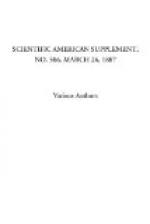In a close stove and in many furnaces the second condition is violated; there is an insufficient supply of air; fresh coal is put on, and the feeding doors are shut. Gas is distilled off, but where is it to get any air from? How on earth can it be expected to burn? Whether it be expected or not, it certainly does not burn, and such a stove is nothing else than a gas works, making crude gas, and wasting it—it is a soot and smoke factory.
Most slow combustion stoves are apt to err in this way; you make the combustion slow by cutting off air, and you run the risk of stopping the combustion altogether. When you wish a stove to burn better, it is customary to open a trap door below the fuel; this makes the red hot mass glow more vigorously, but the oxygen will soon become CO_{2}, and be unable to burn the gas.
The right way to check the ardor of a stove is not to shut off the air supply and make it distill its gases unconsumed, but to admit so much air above the fire that the draught is checked by the chimney ceasing to draw so fiercely. You at the same time secure better ventilation; and if the fire becomes visible to the room so much the better and more cheerful. But if you open up the top of a stove like this, it becomes, to all intents and purposes, an open fire. Quite so, and in many respects, therefore, an open fire is an improvement on a close stove. An open fire has faults, and it certainly wastes heat up the chimney. A close stove may have more faults—it wastes less heat, but it is liable to waste gas up the chimney—not necessarily visible or smoky gas; it may waste it from coke or anthracite, as CO.
You now easily perceive the principles on which so-called smoke consumers are based. They are all special arrangements or appendages to a furnace for permitting complete combustion by satisfying the two conditions which had been violated in its original construction. But there is this difficulty about the air supply to a furnace: the needful amount is variable if the stoking be intermittent, and if you let in more than the needful amount, you are unnecessarily wasting heat and cooling the boiler, or whatever it is, by a draught of cold air.
Every time a fresh shovelful is thrown on, a great production of gas occurs, and if it is to flame it must have a correspondingly great supply of air. After a time, when the mass has become red hot, it can get nearly enough air through the bars. But at first the evolution of gas actually checks the draught. But remember that although no smoke is visible from a glowing mass, it by no means follows that its combustion is perfect. On an open fire it probably is perfect, but not necessarily in a close stove or furnace. If you diminish the supply of air much (as by clogging your furnace bars and keeping the doors shut), you will be merely distilling carbonic oxide up the chimney—a poisonous gas, of which probably a considerable quantity is frequently given off from close stoves.




